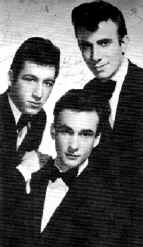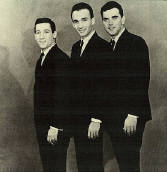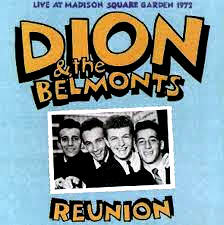|
|
|
|
|
|
Members:
Carlo Mastrangelo - lead - replaced by
Frank Lyndon (1962) repaced by Warren Gradus (1972) replaced by
Dan Elliot (1974) relaced by Freddie Cannon (1976)
Angelo D'Aleo - first tenor
Fred Milano - second tenor

(L-R) Angelo D'Aleo, Fred Milano, Carlo
Mastrangelo
In 1960, Dion decided to pursue a solo career and parted company with the Belmonts. The usual perception is that the group disappeared after this, but the truth is that the Belmonts continued to enjoy success for the first year after his departure. The trio remained with Laurie Records for one single, "We Belong Together," featuring Carlo Mastrangelo as lead singer, and then formed their own label -- originally named Surprise, and then Sabrina, it was finally christened Sabina Records when those two earlier choices proved to belong to other companies. The label became active (as Surprise) in March of 1961 with the recording of "Tell Me Why," which rose to number 18 nationally. The follow-up record late that summer, "Don't Get Around Much Anymore," rose to a modest number 57, and the next release, "I Need Someone," only got to 75.

L-R: Fred Milano, Angelo D'Aleo and Frank Lyndon
The Belmonts' fortunes picked up again with their Sabina single "Come On Little Angel," written by Ernie Maresca. Produced by Gerry Granahan, an established songwriter and recording star (as Dickie Do & the Don'ts), who also oversaw the operations of the company, the single got to number 28 during the summer of 1962. The group also made a bad miscalculation around this time when Maresca offered them the first crack at a song entitled "The Wanderer," and the Belmonts turned it down, only to see it become a massive hit -- indeed, a signature tune -- for Dion. A major lineup change then occurred, when a split developed within the group over their business affairs and the financial condition of Sabina Records; Mastrangelo exited the Belmonts in favor of trying to record solo for Laurie Records. The group carried on, replacing him with Frank Lyndon, and released their first LP, Carnival of Hits, late in 1962 to try and capitalize on "Come On Little Angel."
Sabina Records began diversifying its catalog
slightly, releasing "Time to Dream," which was credited
to Buddy Christie and Buddy Sheppard, with the Belmonts singing
back up as "the Holidays." They also recorded material
by a friend of theirs from the Bronx, Pete Barin, but the label
couldn't seem to click with any records except those by the
Belmonts themselves, and that was changing. By 1963, the Belmonts
were not only struggling for a hit, and battling the woefully
under-financed condition of their record label, but also changes
in public taste. Dion had managed to keep his music current as a
solo performer and racked up some huge hits in the process,
through 1963, but the Belmonts, by the nature of their name and
their harmony sound, seemed more dated. A brief revival in doo
wop music in 1961 had been a godsend to the trio, in terms of
bookings as well as record sales, and there'd been lots of work
in New York and the surrounding area, at a time when they were
just coming off of several big hits with Dion. By this time,
there were other harmony-based groups out there recording and
adding their own respective wrinkles to the music, including the
Beach Boys and, closer to home, the East Coast-based Jay &
the Americans and the Four Seasons, both of whom had a more
commercial sound than the Belmonts. The sales of their own
records began declining around this time,
"Diddle-Dee-Dum" getting to number 53 and
"Ann-Marie" to number 86 in 1963.
Sabina Records struggled on through a handful of additional
releases by the Belmonts that never charted, and finally, in
1964, folded. The group moved to United Artists Records that
year, and cut their final recordings from this part of their
history there in 1966. The trio disbanded that year, although
they were back together in 1967 on ABC Records with Together
Again, an album that reunited them with Dion. The group remained
active after this, cutting an album entitled Summer Love on the
Dot Records label in 1969.

The group next became visible in the early '70s, amid the oldies boom. They cut an album for Buddah Records entitled Cigars Acappela Candy, on which they performed several classic oldies tracks and also applied their sound to contemporary hits like "My Sweet Lord" and "Na Na Hey Hey (Kiss Him Goodbye)." In 1972, however, they reunited with Dion for what proved to be the biggest single gig in their history, a performance at New York's Madison Square Garden, which was not only a sell-out event but also recorded for posterity and released as Live at Madison Square Garden 1972. Milano, Mastrangelo, and D'Aleo were the participants in that performance, which was reportedly released two different ways -- the original Warner Bros. LP was heavily sweetened in the studio, where the subsequent reissues (including the Rhino CD) were made from untouched tapes from the original show. The Madison Square Garden show and its aftermath, which included performances together in 1973 as well, basically allowed all concerned to grab their moment of glory. Dion resumed his solo career, while the Belmonts continued working and got another LP of their own out in 1978, entitled Cheek to Cheek, and generated a nostalgia-laced hit in 1981 entitled "Let's Put the Fun Back in Rock N Roll," on which they were teamed with Freddy Cannon, another veteran of early '60s rock & roll. The group's vintage post-Dion work resurfaced on Relic Records and the Ace label from England, which has made it part of it's reasons for existence to reissue seemingly every available note of music by both Dion and the Belmonts, and as of 1996, Fred Milano remained active representing the Belmonts.
Fred Milano passed away from lung cancer January
1, 2012 at the age of 72.
Carlo Mastrangelo passed away April 4, 2016 at the age of 78.